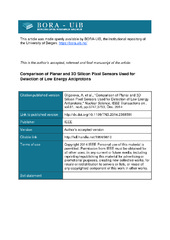| dc.contributor.author | Gligorova, Angela | eng |
| dc.contributor.author | Holmestad, Helga Margrete | eng |
| dc.contributor.author | Huse, Torkjell | eng |
| dc.contributor.author | Kaltenbacher, Thomas | eng |
| dc.contributor.author | Pacifico, Nicola | eng |
| dc.contributor.author | Røhne, Ole Myren | eng |
| dc.contributor.author | Sandaker, Heidi | eng |
| dc.contributor.author | Zmeskal, Johann | eng |
| dc.date.accessioned | 2015-03-23T10:23:30Z | |
| dc.date.available | 2015-03-23T10:23:30Z | |
| dc.date.issued | 2014-12 | eng |
| dc.identifier.issn | 0018-9499 | en_US |
| dc.identifier.uri | https://hdl.handle.net/1956/9610 | |
| dc.description.abstract | The principle aim of the AEḡIS experiment at CERN is to measure the acceleration of antihydrogen due to Earth’s gravitational field. This would be a test of the Weak Equivalence Principle, which states that all bodies fall with the same acceleration independently of their mass and composition. The effect of Earth’s gravitational field on antimatter will be determined by measuring the deflection of the path of the antihydrogen from a straight line. The position of the antihydrogen will be found by detecting its annihilation on the surface of a silicon detector. The gravitational measurement in AEḡIS will be performed with a gravity module, which includes the silicon detector, an emulsion detector and a scintillating fibre time-offlight detector. As the experiment attempts to determine the gravitational acceleration with a precision of 1 %, a position resolution better than 10 μm is required. Here we present the results of a study of antiproton annihilations in a 3D silicon pixel sensor and compare the results with a previous study using a monolithic active pixel sensor. This work is part of a larger study on different silicon sensor technologies needed for the development of a silicon position detector for the AEḡIS experiment. The 3D detector together with its readout electronics have been originally designed for the ATLAS detector at the LHC. The direct annihilation of low energy antiprotons (∼ 100 keV) takes place in the first few μm of the silicon sensor and we show that the charged products of the annihilation can be detected with the same sensor. The present study also aims to understand the signature of an antiproton annihilation event in segmented silicon detectors and compares it with a GEANT4 simulation model. These results will be used to determine the geometrical and process parameters to be adopted by the silicon annihilation detector to be installed in AEḡIS. | en_US |
| dc.language.iso | eng | eng |
| dc.publisher | IEEE | en_US |
| dc.relation.ispartof | <a href="http://hdl.handle.net/1956/9607"_blank">Development and data analysis of a position detector for AEḡIS (Antimatter Experiment: Gravity, Interferometry, Spectroscopy)</a> | en_US |
| dc.title | Comparison of planar and 3D silicon pixel sensors used for detection of low energy antiprotons | en_US |
| dc.type | Peer reviewed | |
| dc.type | Journal article | |
| dc.description.version | acceptedVersion | en_US |
| dc.rights.holder | Copyright 2014 IEEE. Personal use of this material is permitted. Permission from IEEE must be obtained for all other uses, in any current or future media, including reprinting/republishing this material for advertising or promotional purposes, creating new collective works, for resale or redistribution to servers or lists, or reuse of any copyrighted component of this work in other works. | en_US |
| dc.identifier.doi | https://doi.org/10.1109/tns.2014.2368591 | |
| dc.identifier.cristin | 1218473 | |
| dc.source.journal | IEEE Transactions on Nuclear Science | |
| dc.source.40 | 61 | |
| dc.source.14 | 6 | |
| dc.source.pagenumber | 3747-3753 | |
